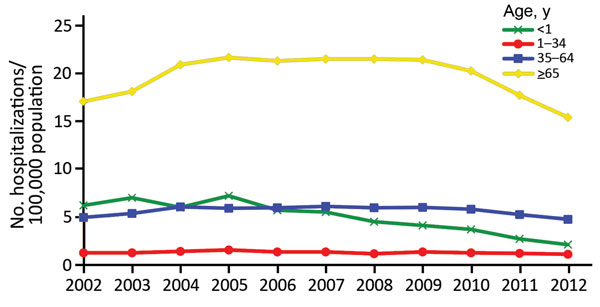Volume 23, Number 1—January 2017
CME ACTIVITY - Research
Epidemiology of Hospitalizations Associated with Invasive Candidiasis, United States, 2002–20121
Figure 2

Figure 2. Annual rate of invasive candidiasis–associated hospitalizations by age, United States, 2002–2012. Neonates (<1 mo of age) were excluded from <1 population. Data were provided by State Inpatient Databases through the Healthcare Cost and Utilization Project maintained by the US Agency for Healthcare Research and Quality. Diagnoses were classified by using Agency for Healthcare Research and Quality clinical classification software (17) and multiple codes and ranges from the International Classification of Diseases, 9th Revision, Clinical Modification.
References
- Kullberg BJ, Arendrup MC. Invasive Candidiasis. N Engl J Med. 2015;373:1445–56. DOIPubMedGoogle Scholar
- Wisplinghoff H, Ebbers J, Geurtz L, Stefanik D, Major Y, Edmond MB, et al. Nosocomial bloodstream infections due to Candida spp. in the USA: species distribution, clinical features and antifungal susceptibilities. Int J Antimicrob Agents. 2014;43:78–81. DOIPubMedGoogle Scholar
- Magill SS, Edwards JR, Bamberg W, Beldavs ZG, Dumyati G, Kainer MA, et al.; Emerging Infections Program Healthcare-Associated Infections and Antimicrobial Use Prevalence Survey Team. Multistate point-prevalence survey of health care-associated infections. N Engl J Med. 2014;370:1198–208. DOIPubMedGoogle Scholar
- Yapar N. Epidemiology and risk factors for invasive candidiasis. Ther Clin Risk Manag. 2014;10:95–105. DOIPubMedGoogle Scholar
- Doi AM, Pignatari AC, Edmond MB, Marra AR, Camargo LF, Siqueira RA, et al. Epidemiology and microbiologic characterization of nosocomial candidemia from a Brazilian national surveillance program. PLoS One. 2016;11:e0146909. DOIPubMedGoogle Scholar
- Pfaller MA, Andes DR, Diekema DJ, Horn DL, Reboli AC, Rotstein C, et al. Epidemiology and outcomes of invasive candidiasis due to non-albicans species of Candida in 2,496 patients: data from the Prospective Antifungal Therapy (PATH) registry 2004-2008. PLoS One. 2014;9:e101510. DOIPubMedGoogle Scholar
- Gudlaugsson O, Gillespie S, Lee K, Vande Berg J, Hu J, Messer S, et al. Attributable mortality of nosocomial candidemia, revisited. Clin Infect Dis. 2003;37:1172–7. DOIPubMedGoogle Scholar
- Wisplinghoff H, Bischoff T, Tallent SM, Seifert H, Wenzel RP, Edmond MB. Nosocomial bloodstream infections in US hospitals: analysis of 24,179 cases from a prospective nationwide surveillance study. Clin Infect Dis. 2004;39:309–17. DOIPubMedGoogle Scholar
- Eggimann P, Garbino J, Pittet D. Epidemiology of Candida species infections in critically ill non-immunosuppressed patients. Lancet Infect Dis. 2003;3:685–702. DOIPubMedGoogle Scholar
- Diekema D, Arbefeville S, Boyken L, Kroeger J, Pfaller M. The changing epidemiology of healthcare-associated candidemia over three decades. Diagn Microbiol Infect Dis. 2012;73:45–8. DOIPubMedGoogle Scholar
- Myerowitz RL, Pazin GJ, Allen CM. Disseminated candidiasis. Changes in incidence, underlying diseases, and pathology. Am J Clin Pathol. 1977;68:29–38. DOIPubMedGoogle Scholar
- Cleveland AA, Farley MM, Harrison LH, Stein B, Hollick R, Lockhart SR, et al. Changes in incidence and antifungal drug resistance in candidemia: results from population-based laboratory surveillance in Atlanta and Baltimore, 2008-2011. Clin Infect Dis. 2012;55:1352–61. DOIPubMedGoogle Scholar
- Wilson LS, Reyes CM, Stolpman M, Speckman J, Allen K, Beney J. The direct cost and incidence of systemic fungal infections. Value Health. 2002;5:26–34. DOIPubMedGoogle Scholar
- Cleveland AA, Harrison LH, Farley MM, Hollick R, Stein B, Chiller TM, et al. Declining incidence of candidemia and the shifting epidemiology of Candida resistance in two US metropolitan areas, 2008-2013: results from population-based surveillance. PLoS One. 2015;10:e0120452. DOIPubMedGoogle Scholar
- Healthcare Cost and Utilization Project. State Inpatient Databases, 2002–2012. Rockville (MD): Agency for Healthcare Research and Quality [cited 2016 Apr 14]. https://www.hcup-us.ahrq.gov/sidoverview.jsp
- Healthcare Cost and Utilization Project. Clinical Classifications Software (CCS) for ICD-9-CM, 2002–2012. Rockville (MD): Agency for Healthcare Research and Quality [cited 2016 Apr 14]. https://www.hcup-us.ahrq.gov/toolssoftware/ccs/ccs.jsp
- Healthcare Cost and Utilization Project. Cost-to-charge files, 2002–2012. Rockville (MD): Agency for Healthcare Research and Quality [cited 2016 Apr 14]. https://www.hcup-us.ahrq.gov/db/state/costtocharge.jsp
- Finkler SA. The distinction between cost and charges. Ann Intern Med. 1982;96:102–9. DOIPubMedGoogle Scholar
- US Department of Labor. Bureau of Labor Statistics. Chained consumer price index for all urban consumers (C-CPI-U) 2002–2015, medical care [cited 2016 Apr 14]. http://www.bls.gov/data/
- Clancy CJ, Nguyen MH. Undiagnosed invasive candidiasis: incorporating non-culture diagnostics into rational prophylactic and preemptive antifungal strategies. Expert Rev Anti Infect Ther. 2014;12:731–4. DOIPubMedGoogle Scholar
- Asti L, Newland J, Zerr D, Elward A, Leckerman K, Guth R, et al. Multi-center validation of ICD-9 codes for candidemia in a pediatric population. In: Abstracts of the 48th Infectious Disease Society of America Meeting, Vancouver, British Columbia, Canada, Oct 22–24. Arlington (VA): Infectious Diseases Society of America; 2010. Abstract 561.
- Clancy CJ, Nguyen MH. Finding the “missing 50%” of invasive candidiasis: how nonculture diagnostics will improve understanding of disease spectrum and transform patient care. Clin Infect Dis. 2013;56:1284–92. DOIPubMedGoogle Scholar
- Walker TA, Derado G, Cleveland AA, Beldavs ZG, Farley LH. Socioeconomic determinants of racial disparities in candidemia incidence using geocoded data from the Emerging Infections Program (EIP), 2008–2014. In: Abstracts of the 65th Annual Epidemic Intelligence Service (EIS) Conference, Atlanta; May 2–5, 2016. Atlanta: Centers for Disease Control and Prevention; 2016. Abstract P2.11.
- Centers for Disease Control and Prevention (CDC). Vital signs: central line-associated blood stream infections—United States, 2001, 2008, and 2009. MMWR Morb Mortal Wkly Rep. 2011;60:243–8.PubMedGoogle Scholar
- Zaoutis TE, Argon J, Chu J, Berlin JA, Walsh TJ, Feudtner C. The epidemiology and attributable outcomes of candidemia in adults and children hospitalized in the United States: a propensity analysis. Clin Infect Dis. 2005;41:1232–9. DOIPubMedGoogle Scholar
1Preliminary results from this study were presented at the IDWeek 2015 Conference; October 7–11, 2015; San Diego, California, USA.
2Current affiliation: American Cancer Society, Atlanta, Georgia, USA.